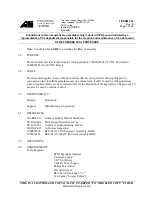
SECTION 2 - GENERAL
2-6
31215825
Hydraulic Lines and Electrical Wiring
Clearly mark or tag hydraulic lines and electrical wiring, as well
as their receptacles, when disconnecting or removing them
from the unit. This will assure that they are correctly rein
-
stalled.
Hydraulic System
Keep the system clean. If evidence of metal or rubber particles
is found in the hydraulic system, drain and flush the entire sys
-
tem.
Disassemble and reassemble parts on clean work surface.
Clean all metal parts with non-flammable cleaning solvent.
Lubricate components, as required, to aid assembly.
Lubrication and Servicing
Components and assemblies requiring lubrication and servic
-
ing are shown in the Lubrication Chart,
(See Section 1)
. Service
applicable components with the amount, type, and grade of
lubricant recommended in this manual, at the specified inter
-
vals. When recommended lubricants are not available, consult
your local supplier for an equivalent that meets or exceeds the
specifications listed.
Batteries
Clean batteries, using a non-metallic brush and a solution of
baking soda and water. Rinse with clean water. After cleaning,
thoroughly dry batteries and coat terminals with an anti-cor
-
rosion compound.
Mast Chain Inspection Procedure
Inspect mast chains for the following conditions:
Wear:
Always inspect that segment of chain that operates
over a sheave. As the chain flexes over the sheaves, joints and
plate edges very gradually wear. Chain “stretch” can be mea
-
sured using a manufacturers wear scale or steel tape. When
chains have elongated 3% they must be removed and
replaced. Refer to Table 2-3 following for proper chain specifi
-
cations and allowable stretch tolerances. Peening and wear of
chain plate edges are caused by sliding over a chain worn con
-
tact face of a sheave, or unusually heavy loads. All of the above
require replacement of the chain and correction of the cause.
Chain side wear, noticeable when pin heads and outside
plates show a definite wear pattern, is caused by misalignment
of the sheave/chain anchors and must be corrected promptly.
Do not repair chains; if a section of chain is damaged, replace
the entire chain set.
Rust and Corrosion: Rust and corrosion will cause a major
reduction in the load carrying capacity of the chain, because
these are primary reasons for side plate cracking. The initial
lubrication at the factory is applied in a hot dip tank to assure
full penetration into the joint. Do not steam clean or degrease
chains. At time of chain installation, factory lube must be sup
-
plemented by a maintenance program to provide a film of oil
on the chains at all times. If chains are corroded, they must be
inspected, especially the outside plates, for cracks in-line with
the pins. If cracks are found, replace the chain; if no cracks are
discovered, lubricate the chains by dipping in heated oil, and
reinstall on the machine. Keep chains lubricated.
Table 2-3. Chain Stretch Tolerance
Chain Size
Pin to Pin
Measurement
Allowable Stretch
.50" pitch
12" or 24 pitches
.24 "/12 in. span
.625" pitch
15" or 24 pitches
.30"/15 in. span
Go to
Discount-Equipment.com
to
order your
parts
















































